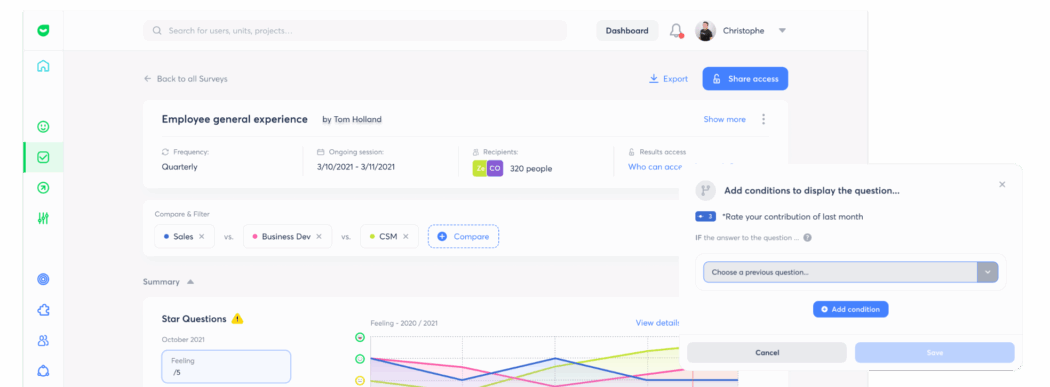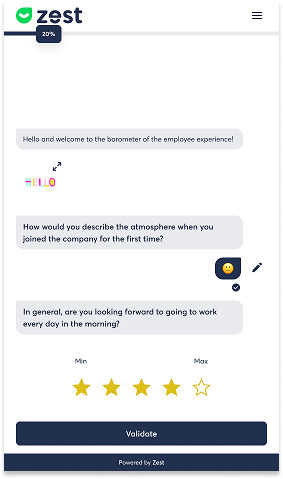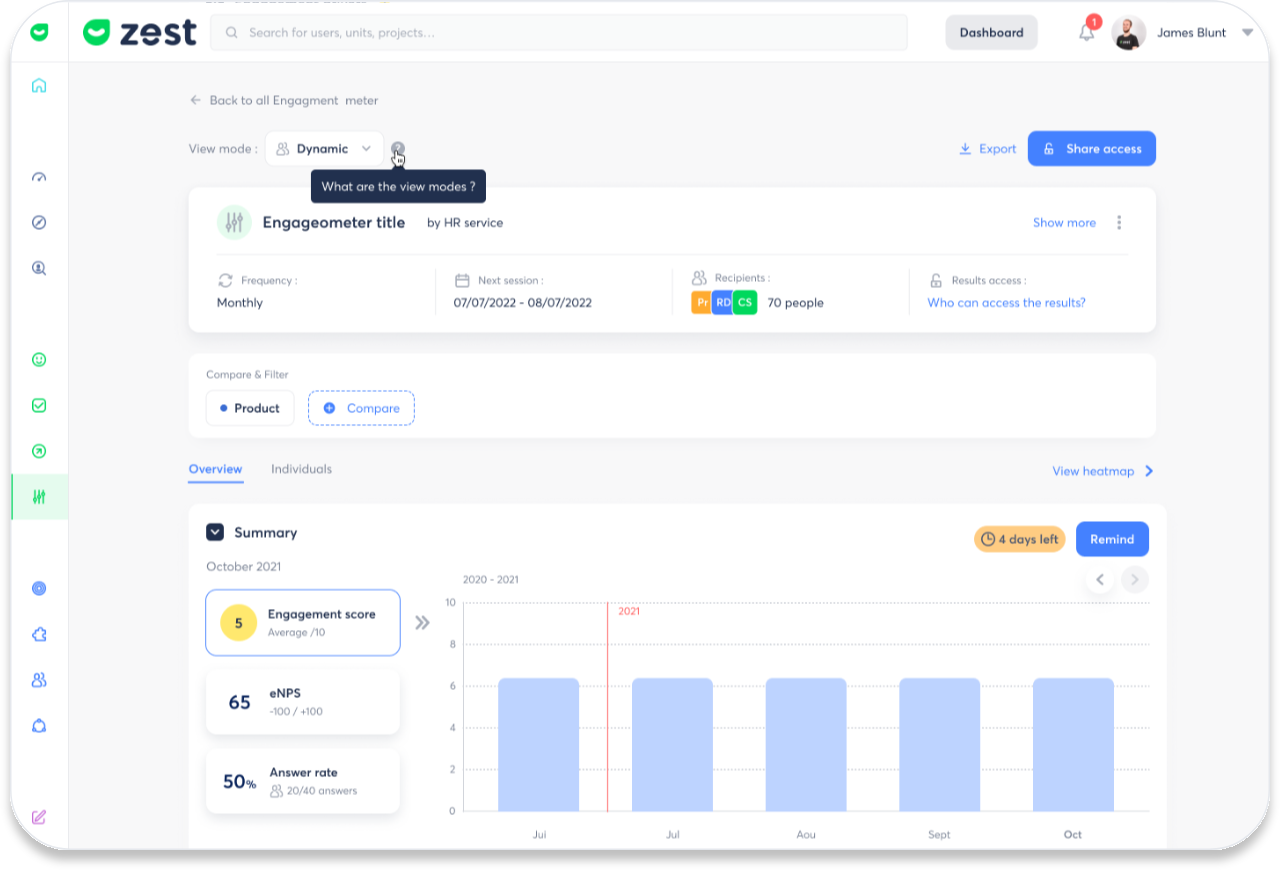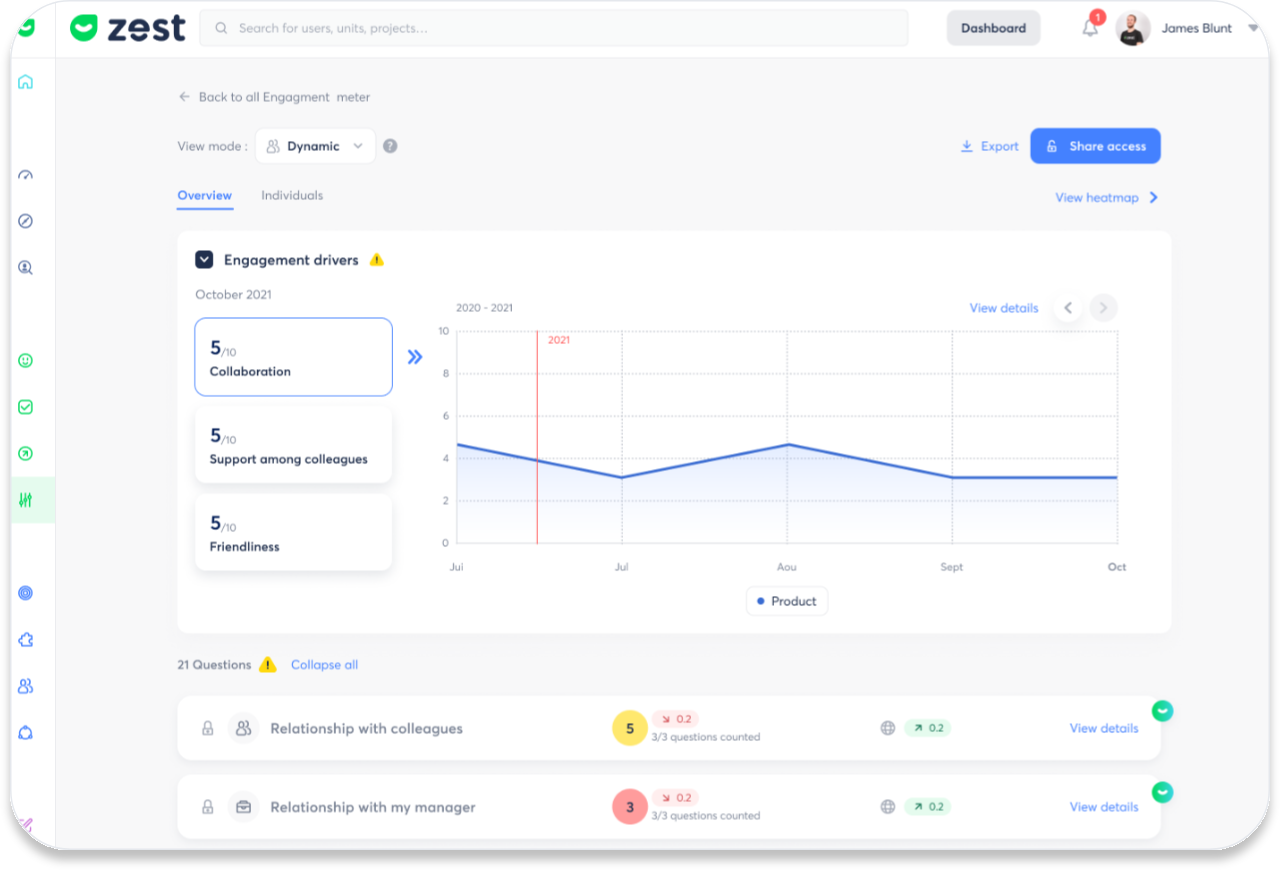Social Barometer: a survey to measure your company’s social climate

Social Barometer: What’s it all about?
The Social Barometer is a survey shared with employees, usually anonymous and confidential, that captures how they perceive the organization and helps you take the pulse of your company.
Its purpose is to support informed, effective decision-making.
The Social Barometer can focus on a specific theme or explore employees’ overall sentiment about how the company operates. It helps identify their main concerns and how they perceive Quality of Work Life (QWL).

Which HR indicators does the social barometer measure?
The Social Barometer provides a comprehensive diagnosis of your organization, aligned with your key HR priorities. It draws on both sentiment-based and HR performance indicators, whether quantitative or qualitative, such as well-being and job satisfaction, engagement, employee experience, and turnover rates.
In today’s fast-changing world of work, where talent is volatile and competition is fierce, these insights help you anticipate shifts and strengthen your company’s collective resilience. Identifying friction points and taking action accordingly becomes a powerful lever for growth and performance.
HR indicators: a quick overviewment
HR indicators are now an essential tool for HR teams. They serve as a true dashboard for the company, providing a clear snapshot at a given moment and offering a precise, objective understanding of the organization’s internal state.
1
Identify risk situations in real time
2
Measure the performance of HR teams and the impact of their initiatives
3
Improve internal communication by addressing real employee needs
4
Track the impact of your initiatives
Which key indicators should you be tracking?
- Overall employee satisfaction: Level of satisfaction, work environment, and working conditions.
- Employee engagement: Measures employee involvement and motivation.
- Workplace well-being: Assesses quality of work life, including stress management and more.
- Social climate and internal relationships: Measures the quality of relationships between employees.
- Compensation and benefits: Assesses employee perception of fairness and competitiveness in salaries and benefits.
- Managerial relationships: Assesses employee satisfaction with their direct managers.
- Quality of Work Life (QWL): Measures the overall factors that contribute to employee well-being in the workplace.
 Social Barometer: why measure sentiment indicators?
Social Barometer: why measure sentiment indicators?
Sentiment indicators are essential. They complement hard HR performance data by revealing strengths and early warning signs that might otherwise go unnoticed. Satisfaction, engagement, team morale, stress levels, workload distribution, and management quality all provide valuable insights. These indicators offer a clear view of the true employee experience.
 Social Barometer: what about HR performance indicators?
Social Barometer: what about HR performance indicators?
HR performance indicators provide a big-picture view of your workforce and internal social climate. Absenteeism and turnover are key metrics. They help you assess how your company’s culture and strategy are impacting your teams.
Best practices for a successful Social Barometer!
Set clear objectives : Measure engagement and guide strategic actions.
Ask relevant questions : Include key indicators and keep it under 30 questions.
Maintain the right frequency : Semi-annual or annual rhythm to avoid survey fatigue.
Combine with other tools : Use Pulse surveys for regular follow-ups and One-to-One meetings for individual insights.
Act on the results : Turn insights into concrete actions and track their impact.


Why implement a Social Barometer?
- To collect accurate, honest, and meaningful feedback, and give your employees a real space to speak up
- To take the pulse of your teams and detect potential issues early, before they escalate into conflicts
- To ensure strong Quality of Work Life (QWL) and working conditions
- To identify key areas for improvement
- To help HR teams take action in an objective and realistic way
With Zest, you can regularly and precisely measure employee satisfaction. This not only helps assess your company’s social climate, but also supports the rollout of modern management practices that foster a culture of continuous feedback and communication.
How do you run an effective and engaging survey?
Zest: the ideal launch tool. With Zest, launching a survey takes just a few clicks, either by using a ready-made template like the “monthly barometer” or by building your own from scratch based on your specific needs.
Many social barometers fail to engage employees, leading to drop-offs or complete non-responses. They don’t inspire participation and often miss the mark.
Here are a few best practices to engage your teams without losing valuable insights, and to ensure your survey and social climate audit are truly effective through agile and recurring rituals.
1
Define the frequency of your Social Barometers
Decide on the frequency before launching your first barometer.
With Zest, you can run your survey as a one-off or set it on a recurring basis: weekly, monthly, quarterly, or annually.
2
Share the results and harness collective intelligence
Transparency and communication are key to engagement and success.
With Zest, you can customize result access by team, department, or location. Sharing the results creates an opportunity to openly discuss solutions to the issues raised.
3
Implement concrete action plans
Your barometer should never be left unanswered. It must be followed by concrete action.
With Zest, you can launch action plans based on the areas for improvement identified through the Engageometer. It even offers customizable plan templates to guide your next steps. And once again, don’t forget to communicate along the way.
The importance of survey format
To maximize participation rates, your Social Barometer needs to be engaging for respondents. Here’s how:
 Plan ahead:
Plan ahead:
Prepare thoroughly to get the insights you’re looking for What are your key HR and business priorities? What resources will you need (budget, people, tools)? Make sure to communicate clearly about the process to engage respondents, emphasizing the importance of anonymity.
 Avoid unnecessary questions:
Avoid unnecessary questions:
If someone hasn’t used a tool, they won’t be able to answer a question about it.
 Keep surveys short and impactful:
Keep surveys short and impactful:
The length of the Social Barometer shouldn’t be a barrier, neither for employees answering it nor for you when analyzing the results.
 Use a variety of response types:
Use a variety of response types:
Make your survey dynamic. Use multiple-choice (single or multiple answers), sliders (0 to 10 scales), star ratings (1 to 5), open-ended questions… mix it up!
The importance of survey frequency
Ideally, surveys should be conducted regularly, following the never-ending survey approach.
In a company, the context changes fast. The goal is to regularly assess employee sentiments early enough to address frustrations and early warning signs through concrete actions. It also allows you to track the impact of action plans over time and manage them closely: a true win-win!
Measure your company’s social climate
Measuring the overall mood and social climate of your company is a type of Social Barometer typically conducted once or twice a year.
In Zest, several features support this measurement: frequent mood tracking, targeted Pulse surveys, and the Engageometer to measure and understand engagement and motivation drivers.

Measure specific HR indicators
Targeted surveys can be launched on themes such as onboarding, company culture, CSR engagement, internal communication, HR projects, and more.
With Zest, the survey feature lets you run these types of surveys either as one-offs or on a recurring basis. You can also translate your survey into 23 languages and launch it simultaneously across multiple countries.

FAQ
Do you have any questions?
Zest’s flagship Social Barometer model is the Engageometer: 20 questions crafted by our QWL experts that allow benchmarking, plus customizable questions tailored to your needs.
Additionally, Zest offers a library of ready-to-use, customizable templates designed by our occupational psychology specialists. These include monthly barometers, surveys on Quality of Work Life (QWL), trust climate assessments, and organizational change surveys.
It depends on your objectives. Anonymity guarantees honest, unbiased responses, improving data quality. On the other hand, non-anonymous responses enable individual follow-up and personalized action plans.
Zest lets you configure survey anonymity in three ways: full anonymity for all, respondent choice, or public responses only. You can also set a minimum number of respondents to ensure confidentiality.
Yes, there are industry-specific Social Barometers tailored to the unique challenges and needs of different sectors to best capture each industry’s specific issues.
Zest’s solution enables you to create custom Social Barometers designed to meet the specific needs of any company, regardless of its sector.
Quality of Work Life (QWL) refers to the set of actions and conditions that balance improving working conditions with overall company performance.
To effectively measure Quality of Work Life (QWL), several complementary actions can be implemented:
1. Annual questionnaires
2. “Pulse” surveys
3. ENPS (Employee Net Promoter Score)
4. Dashboards and tracking indicators
5. Direct observations
6. Dynamic management tools
In this context, Zest offers an integrated approach to measuring and improving QWL:
Mood of the day: A feature that regularly gauges employee morale.
Pulse surveys: Short, targeted polls on specific topics such as onboarding or company culture.
Engageometer: A turnkey tool to measure engagement and motivation drivers.
Customizable surveys: Create tailored surveys to meet your company’s specific needs.
Social Barometer: A comprehensive tool that assesses social climate and tracks engagement over time.
Idea box: Encourages employees to share suggestions to improve QWL.
More Zest news

Mastering the professional development interview: key strategies and best practices

fixed-term contracts and annual reviews: 5 keys to a successful evaluation
